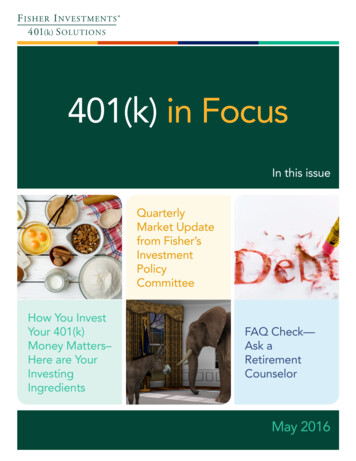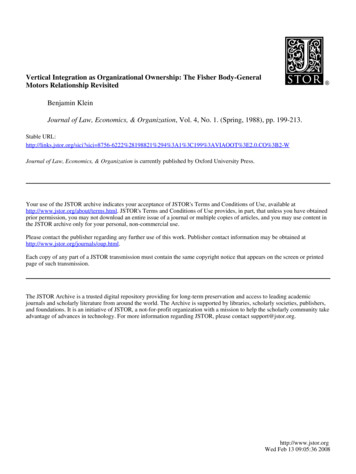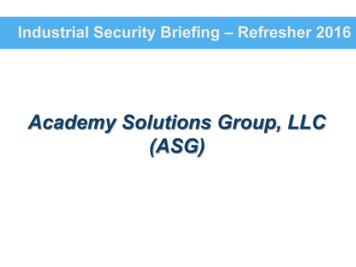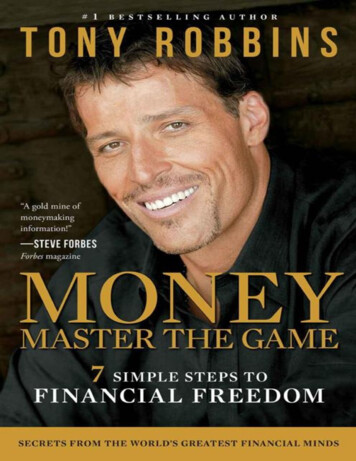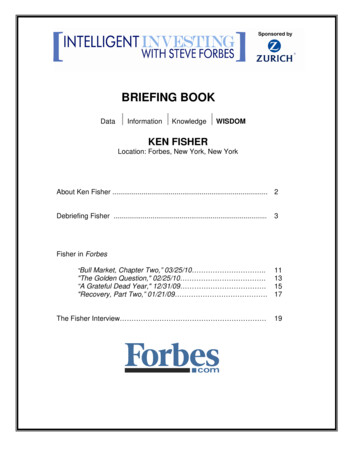
Transcription
BRIEFING BOOKDataInformationKnowledgeWISDOMKEN FISHERLocation: Forbes, New York, New YorkAbout Ken Fisher . 2Debriefing Fisher .3Fisher in Forbes"BullMarket, Chapter Two,” 03/25/10 ."The Golden Question," 02/25/10 .“A Grateful Dead Year," 12/31/09 ."Recovery, Part Two,” 01/21/09 .11131517The Fisher Interview 19
ABOUT KEN FISHERIntelligent Investing with Steve ForbesKen Fisher is founder, chairman and chief executive officer ofFisher Investments, a money management firm.Fisher has been a Forbes columnist for over 25 years. According toCXO Advisory Group’s “Guru Grades”, he is the second mostaccurate stock market forecaster over the past few years. Fisherwas ranked 721 on Forbes' 2010 World's Billionaires list.He has written six books; his latest book, How To Smell A Rat,came out last year. Fisher's other books are: The Ten Roads ToRiches, The Only Three Questions That Count, Super Stocks, TheWall Street Waltz and 100 Minds That Made The Market.In the 1970s, Fisher's work helped to develop the price-to-sale ratio, which is now part ofthe financial lexicon. Last year, he was given the first Tiburon Strategic Advisors CEOSummit award for "challenging conventional wisdom". That year, Charles Schwab alsoreceived that award for "focusing on customer needs."Fisher enjoys studying the history of Kings Mountain, California, 19th century redwoodlumbering history and other aspects of redwood science. He and his wife, Sherrilyn, live inWoodside, California. They have three sons and two grandchildren.-2-
DEBRIEFING FISHERIntelligent Investing with Steve ForbesInterview conducted by Alexandra ZendrianApril 5, 2010Forbes: You seem to be pretty bullish about the markets now. What gives you that kind ofconfidence?Ken Fisher: First, skepticism and pessimism are very high. There's a phrase I've used inmy Forbes columns called the pessimism of disbelief, which is there's a societal trend,both within media and you can see on Internet postings everywhere, commentaries, thatall things bad are bad, and things good are likely to turn into something bad.This is, in my thinking, the classic wall of worry that bull markets like to climb because highpessimism and negativity today is already priced into securities. Anything that isn't thatbad in the future is a positive surprise, and any positive surprise is always bullish.Secondarily, stocks are still historically, while not as cheap as they were a year ago, likeany other standard, extraordinarily cheap compared to competitive investment sources likefixed income, et cetera. For example, you will read commonly that, people saying, "Stockscan't do well because from here interest rates must rise," and I say, "Okay, maybe, fairenough."But to get the tradeoff between 10-year government bond, not in America, but on a globalbasis, and the inverse of the PE or the earnings yield back to historical norms, long terminterest rates would have to fully double from here globally. Which is huge. That is, stocksare still cheap. They're cheap by any comparative value standard. Many people saythings like, "The P/E has to hit single digit levels before we can have a sustainablemarket." If you actually study history, that's ridiculous. It's just silly, it's wrong, andsecondarily, it's just wrong in terms of theory to think of P/E by itself as a meaningfulconcept. That is, the only way you actually engage in finance is if you compare the cost ofthis, to the cost of that. And so, when you think of relative evaluations, any way youmeasure them, stocks are cheap.Thirdly, on a global basis, the economy's expanding at a pretty good clip. It's notexpanding in the way that Americans are used to seeing it, in that Americans are used to aworld where America leads, and we're now in a world where the 25% of global GDP, thatis the emerging markets nations is not only growing but growing rapidly across the board;some countries, obviously, more than others.But overall, at a rate that's two times that of the developed world. And that block, forexample, is bigger than America's contribution to global GDP. That's also a point thatAmericans have some difficulty absorbing, and pulls, America and Europe along fartherand faster than we expect. So, the way most people in most countries think, and-3-
Americans particularly, is they look around them, and they see what's around them, andthey extrapolate from that.In this world, where the world is inherently globally positively correlated, that's an irrationalway to proceed, even though most people do that. So, we have an economy that'sexpanding, we have earnings that are expanding, we have things that are perfectlyobvious like, in the non-bank world, the strongest balance sheets relative to an economiccycle that we've ever seen. That is, the non-bank corporate world is sitting on more cash.The thing that frightened us so much, the financial crisis, is deader than a doornail, in thatif you look at, for example, first quarter jump bond borrowings they're at record levels,which says, that the ability for lower quality corporations to borrow, which they couldn't doa year ago, is back. And ironically, the bears were bearish a year ago, and two years ago,on the notion that low quality companies couldn't borrow. Now they're bearish on thenotion that low quality corporations can borrow, thinking that a low quality corporateborrower is risky. But you can't have it both ways. You can't say, it's bearish if they can'tborrow, and then say, it's bearish that they can borrow.Which side of the argument do you think is more valid?Fisher: I think that the prior one, that they can't borrow, is more valid than the one thatthey can borrow. The fact of the matter is that that they can borrow means that they willhave the money to spend on things, and that means they'll have the money to spend onexpansion.And of course, then what happens next, I believe, is that small businesses will be able toborrow, which has been you know, if you go back a year ago, and you were Microsoft, youcould still borrow all the money you wanted. Because if you were, you know, a AAA ratedcorporation, you didn't have any problem borrowing money. But if you were BBB rated,you had some trouble, and if you were lower than BBB rated, it was nearly impossible, andif you a little company, a tiny company, trying to go the bank and borrow, you might as welljust forget about it.That world, this year, has flip-flopped, and people don't think that through. But a)companies have cash, b) companies can borrow, c) it's not going to be very long beforesmall companies can borrow, and the banks are going to be more and more eager to lendbecause, and this is a perfectly obvious elephant in the living room.But we have the steepest yield curve that we've had in the last 40 years, and yield curvesteepness is an overly simple sense a predictor of future bank system eagerness to lend.Because the core business of banking is taking in money at short term interest rates, andlending it back out at long term interest rates. So when the yield curve is steeper, bankshave a fatter future gross operating profit margin. And the analogy that I make, andanybody who's ever dieted knows, is that it's easy to stay away from pizza, as long as youdon't eat the first piece. But once you eat the first piece, the rest of the pizza that's sittingthere is pretty much in jeopardy.-4-
And as banks make these loans that they're making now at this steep yield curve, they'llbecome more and more eager to make more loans, which will then ripple out through theworld, and will have an expanses world that's exactly the reverse of the function that got ushere.Pessimism, on the one hand, you know, sick pessimism, and cheap stocks, expandingglobal economy led by the part of the world we're not used to seeing it. Increased ability ofcash rich corporations to be able to borrow, which will increase as the banking system ofthe next year becomes ever more eager to lend.What would your advice be to retail investors? Are there any particular sectors thatlook good or is there some kind of philosophy that they should keep in mind?Well, the first part, I would say is what I would always say, which is, the most importantthing that an investor should do is know himself or herself. And then, second, he shouldalways ask, what am I trying to accomplish here? And for most people, the most commonthing that I hear people say the purpose of their money is, is something like, "To take careof me and my spouse for the rest of our lives, and maybe leave some money to ourchildren," stuff like that.For those normal people, then the next question that finance theory would ask them toconsider is, do I know something other people don't know? And for most of them, theanswer's going to be, no, they don't. And if you don't really know something other peopledon't know, what finance theory says you should do is, largely be passive.That is that if you try to make decisions based on the same information everybody elsehas, you're going to sometimes be right, more often wrong, and overall do worse than ifyou did nothing at all. So what that argues for is kind of, owning a passive array of theworld market, and just sitting on it, and not trying to be too cute. But the advice that Iwould be rendering is, don't listen to all of the people who tell you that based on all of thethings that we've just been through, we now have a terrible decade ahead, and thereforeyou shouldn't own stocks.Because every cycle that I have ever seen in my 38-year career in this industry, or studiedin history, at this stage of the cycle there is always a universe there's always a large voicethat says, "The next 10 years are going to be terrible." That's one of the lessons, the greatlessons of history, is that the aftermath of every bear market is these terrible problems thatgot us into this terrible fix are so huge that it's going to take forever to get over them, andtherefore we're going to have a bad decade ahead.And so my first advice would be, don't pay any attention to that nonsense. The secondpiece of advice is, if you actually think you're a more capable investor, and think you'reable to know things other people don't know, and feel confident to going beyondpassiveness, and of course, passiveness is easy and cheap, you know. It's like, there'snothing wrong with that.-5-
I think it's important to recognize that we're still in the phase of the cycle that I haveidentified in my Forbes columns from early last year, which I considered the first phase ofthe bull market, where the stocks in categories that did better or as well as the market inthe first half of the bear market, but got killed in the back half are leading this bull market.So now that's important to distinguish. That's not the ones that did worse than the bearmarket, it's they did they got killed in the back half, but they did better in the first half. Andso, that includes emerging markets, that includes materials, industrials, consumerdiscretionary, technology, to a lesser extent, energy. It means, underweighting the thingslike, consumer staples, drugs, therefore, in a broader sense, healthcare, utilities, telecom,all of the less economically sensitive things. It means putting yourself into the featureswhere, if the economy is stronger over the next two years than people think it'll be, thosecategories would do well.That's hard for people to do right now. For example, it's hard for people to see why, in aneconomically, what's been an economically tough time, consumer discretionary stocksshould do well. Why do people need to buy big ticket items that are deferrable? But theanswer is, that the way stock markets work, is they price a couple of years out, and acouple of years from now, those categories will be doing much better than they're doingnow, and the stocks tend to move in advance of that.How many years out do you think that they price?The answer to that is it varies over time. But stocks, the market in its fullest sense, isnever pricing out less than about six months into the future, and is never pricing out morethan about 36 months into the future. So, one of the great traps, for example, that peopleset for themselves regularly, is they'll talk about something that's going to happen 10 yearsfrom now with great surety, which I always kind of have a, well, maybe that will happen,maybe it won't.But you know, 10 years from now we're going to have this demographic problem, or10from now we're going to have this climate problem, or 10 years from now we're going tohave this or 10 years from now we're going to have that. And my response to that isalways, well, I don't know if that's going to happen or not, but if you write that that's goingto happen, the stock market's not going to care about it until about, at the earliest, threeyears before it happens.So, even if you're completely right that that's happening, you know, five, 10, 15 years fromnow, don't try to take action on it now, because the market doesn't care about somethingthat far off into the future. It just is, you know, I've trained myself to be disbelieving aboutthis kind of stuff, because I know the markets are disbelieving about this kind of stuff.Let me just kind of give you one more example of that? One current fear that Forbesreaders have quite a lot is, Forbes readers typically being, you know, much more kind of,Republican Conservative, than Liberal Democrat, on average, is they fear the status near-6-
Socialist formulations of the current administration and Congress, and they fear that, youknow, that'll kill the golden goose. And you know, you can see that in lots of places, thatfear.My point on that one again is, well, maybe. I'm prepared to buy that argument, but for thatto actually get very far, if you just play the numbers, it doesn't get very far in the next threeyears. Therefore, it doesn't have much market impact on 2010.But we have an election in about three years, so if people think that way, thenshouldn't they start preparing for three years from now?Well again, the market never discounts out more than that. It may not be discounting outthat far right now. I mean, my point is, the effects of that Socialism, if it's to occur, and bereal, to be the negative thing that they all fear, still won't impact the 2010 stock market.It would be a later stock market it would impact.I mean, that's the part that I think a lot of people have difficulty with. Is, they're so surethere's this big, bad thing out there in the future. Another one that people talk about is, allthe terrible things that are going to happen with all the debt mounting, and I say, well,maybe. But to actually get to those numbers, if you just play them based off of whoever'sestimates you use, to get to those numbers you fear so much, takes this long, and that'sfurther out in the future than the stock market can change in 2010. So don't worry about itthis year. Keep that in the back of your mind, and as we roll forward, maybe that's aproblem. But it's not a problem for this year. That's a hard way for people to think.To go back to something that you were saying before about price to earnings -- whydo you think that more metrics are needed than just price to earnings, and what elsewould you take into consideration? How should a retail investor look at price toearnings?Well, in theory, just if we're getting to kind of tactics, in theory what we really should bethinking about, which we can't think about perfectly, is what would be the future earningsstream that we can get from owning this business or these businesses, compared to otheravailable, relatively safe investment alternatives?Because if the future earnings stream we're going to get from these businesses is highcompared to what we could get from relatively safe alternatives, these businesses areattractive. If it's not high, they're not attractive. This is real, real simple and real basic.Fair enough?So, from there, we just simply say, that if we could forecast earnings perfectly, then theinverse of the P/E, or the earnings yield compared to interest rates four, five, seven yearsout, would be, which again, we can't forecast with any perfection at all. But if we couldforecast that perfectly, we'd just make that forecast, we'd compare it to interest rate, whichis clearly higher. That's what we want.-7-
Oh, this one has a 20% yield, when the government bond rate is, you know, not quite four.Well great, let's take the 20% return, right? That'd be easy. In reality, we can't forecastthat perfectly, so, we have some sense of our forecast, but we want to ameliorate that withother notions, like, you know, more than a quarter century ago I introduced the world to theprice sales ratio. And so, the price-to-sales ratio, which allows you to contemplate attoday's level of price to sales, if in the future they made this gross margin, and is that evenpossible? Let's you look at extreme notions. So, let me just kind of give you an example.If a company's selling at 30% of revenue, then that's the equivalent to 10 times earnings, ifthey were making 3% in that after tax margins. Three percent. And that after tax margins inmany industries might be an easy hurdle to accomplish sometime off in the future. So youdon't have to have a very precise if you understand the basic kind of economics of thisindustry, you might be able to say, in this industry an average company ought to be able tomake that three percent margin at least.I can't tell if it's going to be in 2011, or 2012, or 2013, but I got to believe they're going tobe able to make three percent in that after tax margins. So selling at 30%, that's theequivalent to 10 times earnings. I don't know exactly when that's going to happen, I can'tforecast that precisely, but this is getting me in the ballpark of reasonableness. Is 10 timesearnings something that's attractive?Likewise, by contrast, at the other end of the extreme, you find a lot of companies selling atthree times revenue, as opposed to 30% of revenue, and three times revenue is acompany selling at 30 times earnings, is making 10% in that after tax margin. That's apretty high hurdle to overcome. So when you see the thing that's selling at three timesrevenue, you say to yourself, that thing better have real fat profit margins in the future, anda lot of growth, or that's going to be a disappointing stock.And so particularly at times like the year we've just been through, where earnings in theshort-term are often quite irregular, relative to kind of normalcy, where a lot of companiesfor what are going to be temporary reasons, might have very different profits than theynormally would have. This helped to get you in the ballpark, and to think through, youknow, my P/E forecasts actually might be a little bit off base.Earnings are a very convoluted concept in our society today. And the accounting rulesbehind earnings make them not always as straightforward as we might like. And cash ismore real. So on the one hand, you think about earnings, but then you ameliorate that bythinking about on the one hand, price-to-sales, on the other hand, price cash flow.How you would invest in the emerging markets and how retail investors should getover their fear of the emerging markets?Getting over your fear is an interesting one because that's about the hardest thing forpeople to do. It's very hard when people start off afraid of America to then say, gee, youknow, maybe you want to overweight emerging markets when you're afraid of America.But what I would say is that there's a couple of things to think about. One is that the-8-
emerging markets are emerging and by that, I mean that there's a very long and welldemonstrated process in history that's kind of an inverted J curve.And by an inverted J curve, I mean that as income per capita in a nation has risen aboveabout the 5,000 per person level personal consumption has gone through the roof, andmiddle-classness has exploded. So in category after category, and this is true in thehistory of the United States, true in the history of other countries, and is happening rightnow in emerging markets, as income per capita gets above those levels, you start seeingconsumption of cars, all consumer durables cell phone usage, et cetera, just explode. Andthe features that we normally associate with middle-classness explode. And the thingsthat go with that which we understand pretty well explode. And so if you ask yourself whatare the things that happened to America in the last century in terms of trends, and you lookinto the emerging markets, you actually see them today. And actually look to America'spast to see what happens in those countries in the future. So, for example, if you look inthe developed world, airlines are dog meat companies. If you look in emerging markets,airlines are growth stocks. They make money, they grow rapidly, they keep adding cities.They keep gaining traffic because that J curve concept applies to the airline traffic as well.And that which once upon a time was true in America, which was the airlines were growthstocks.And today, you know, you can't make money in an airline if you have to in America or therest of the developed world. If you go to South America, let's say, it's a growth industry. Ifyou go to China or it's a growth industry. In the same way, things that were even a littleearlier in our development but as simple as electric generation, they're they've got growthattributes to them there. They have high profitability, they have fundamental growthbehind them because the emergent middle class needs the electricity. And so things thatpeople can commonly understand are actually easier to see in emerging markets, which isactually a reason to be more comfortable. And today, if you restrict yourself to theuniverse of depository receipts, you can go on to sites like Forbes, that would be a site,and you can actually look through the stock data on companies that have depositoryreceipts and learn about them. Then you can click over to Wikipedia, let's say, and learnmore about them. And then you could go directly to the company's Web site and read allabout it on the company's Web site and know as much about some company in, let's say,Hungary or Brazil or India as you would about a company in, let's say, Tennessee.And that's the reason that they can feel comfortable because today you can learn as muchabout the company in the emerging market as you could of some company that you mightnot have known very much about that was a medium-sized company on the other side ofAmerica.You know, one of the features that's provably false is people always feel morecomfortable buying stock in a company that's ten miles down the road from them. A littlebit like they tend to like their local sports team. But the fact that your local sports team islocal doesn't mean it's going to win the national championship. And there is nothing aboutlocalness that inherently other than some periods of luck like the tech boom linked to-9-
Silicon Valley if you were in the Bay Area, but other than some, you know, kind of luckyquirks like that there's nothing about localness which tends to breed superior investing.And so when you extrapolate that and think through that today via the Internet, you canlearn about as much in the same amount of time about some company you don't knowanything about on the other side of the world as you would some company on the otherside of the country. Or let's say if you were the San Francisco or New York Forbes readera company in Tennessee. And there's no reason to particularly limit yourself. And this iskind of a, just a simple point for your readers. Almost every one of these emerging marketcompanies actually besides having a pretty good Web site of their own today, for obviousreasons, has a pretty good page on Wikipedia, where you can get a thumbnail sketch inabout two and a half minutes. And then you compare that to all the U.S. companies thatyou don't know anything about.- 10 -
FISHER IN FORBESIntelligent Investing with Steve ForbesPortfolio StrategyBull Market, Chapter TwoKen Fisher, 03.25.10, 08:40 PM EDTForbes Magazine dated April 12, 2010I like what I see: improving fundamentals plus skepticism: the classic ingredients of the secondphase of bull markets.It's a year since the bull market began, and I remain firmly bullish. I'm often wrongly called a permabull.I'm not one. In 25 years of FORBES columns I turned bearish for three extended periods: in 1987, in1990 and between 2000 and 2002. Yes, I completely missed foreseeing the 2008 bear market. But thatdoesn't make me a permabull.When in doubt I am biased toward owning stocks. Stocks rise more often than not. Since bear marketsare always followed by bull markets--which is a basic rule some investors seem unable to accept--itseemed to me basic to be bullish once the 2008 bear market was well under way. One year into thecurrent bull market I like what I see: globally improving fundamentals plus strong societal skepticism.Snarky, cranky sentiment and better fundamentals are the classic ingredients of the second phase ofbull markets.Economic numbers globally and almost consistently keep coming in up and better than expected, whilebeing largely dismissed in terms of significance. In part this is because the fastest recoveries from therecession are happening in the 25% of global GDP found in emerging markets countries. Maybe it'sunnerving that China and Brazil are leading us. Americans are way too U.S.-focused.My Feb. 8 column cited the "pessimism of disbelief," the tendency to see all news as bad, or, if good, assomething likely to morph into something bad. (Typical formulation: Stimulus efforts either won't work orwill cause inflation.) You can see this pessimism in mutual fund flows: For three years there has been amigration into bond funds--mostly into government bonds for safety--just in time for long-term U.S.government bond funds to return a --17.5% in 2009. That's fear.For more on market sentiment, visit market blogs anywhere. The skepticism is wise-guy thick. Anyoneposts something positive and they get pounded by the wiseacres. I love it. This is the wall of worry bullmarkets classically climb. So be bullish while the sentiment's sour--and keep buying good companies atreasonable prices, like these:Brazil's Fibria Celulose (FBR, 22), the old Votorantim Cellulose, at first glance seems neither cheapnor positioned to dominate. But it's about to merge with Brazil's Aracruz to become the global leader inhardwood pulp, with 24% of the market. This is the raw ingredient for high-end paper and ultrasofttissue. The merger implies future pricing power in a market where prices are already firming as- 11 -
inventories shrink. Fibria sells at 20 times projected 2010 earnings and at 90% of book value. Not verycheap. But I'll bet that price will turn out to be 8 times 2011 earnings.Coal is China's energy source. I recommended Yanzhou Coal Mining (YZC, 22) in the July 13 columnat 12. It still has upside. With great reserves in advantageous locations, this low-cost 35-million-ton-peryear (and growing) producer should enjoy fatter profits margins over the next several years. It sells at14 times likely 2010 earnings.Today Big Brother should be watching. Israel's Nice-Systems (NICE, 31) makes voice loggers thatrecord, archive and monitor communications from multiple sources. These complex systems can detectchanges in emotion among voices and are sold to 24,000 customers ranging from multinationals toAustralia's Parliament to police and fire departments. For a steady grower this company is too cheap at17 times 2010 earnings and 1.8 times book value.New Zealand will prosper in part on its proximity to emerging markets. This prosperity will rub off on thedominant phone company, Telecom New Zealand (NZT, 7), which is too cheap at ten times 2010earnings and 80% of annual revenue. You're likely to get an 8% dividend yield over the next year ontoday's price.Weight Watchers (WTW, 25) runs weight-loss cheerleading sessions and licenses its name to vendorsof moderate-calorie prepared foods. Is it hard to envision why the stock should rise and folks shouldshrink their wallets to diet now? Just see it as a classic long-term, moderate-growth consumer stock-just when stocks of expensive brand-name products are doing well. It is, after all, the brand in its field.As consumer income bounces back, people don't have to choose between this and indulgences: Theymight choose both. Weight loss makes them feel better about indulging. This stock was for a very longtime steadily over 35 and often up to 45. It will get back there. At today's price it goes for nine timeslikely 2010 earnings and yields 2.8%.Money manager Ken Fisher's latest book is How to Smell a Rat: The Five Signs of Financial Fraud(John Wiley, 2009). Visit his homepage at www.forbes.com/fisher.- 12 -
Portfolio StrategyThe Golden QuestionKen Fisher, 02.25.10, 01:00 PM ESTForbes Magazine dated March 15, 2010Don't buy a stagnant piece of metal when you could own growth. Central European Media andStarwood Hotels are going to grow.Trying to preserve her youth, Diane de Poitiers, mistress of French King Henry II, died from drinkinggold. Today's world is choking on it. My firm's investment counselors get more questions like "Whatabout gold?" than on any other single topic. Overseas investors are particularly smitten.They shouldn't be. In the 433 months since trading freely following 1973's demise of the Bretton Woodsexchange-rate system, gold has had a 7.1% average annual return, achieved solely from six relativelybrief spikes. These bull markets lasted for 66 months, or 15% of the time. The rest of the time goldsuffered a 3.6% average
KEN FISHER Location: Forbes, New York, New York . Fisher Investments, a money management firm. Fisher has been a Forbes columnist for over 25 years. According to . was ranked 721 on Forbes ' 2010 World's Billionaires list. He has written six books; his latest book, How To Smell A Rat , came out last year. Fisher's other books are: The Ten .
